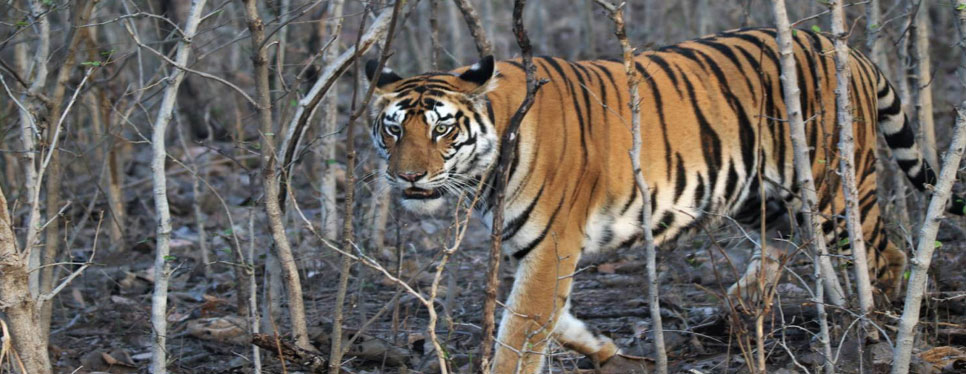Wildlife Heritage of Panna Tiger reserve
By JAGAT (14/06/24) Nestled in the heart of India, Panna National Park stands as a testament to the country’s rich natural heritage. This renowned wildlife sanctuary, located in the state of Madhya Pradesh, covers an expansive area of approximately 542 square kilometers. Recognized for its incredible biodiversity and conservation success, Panna offers a unique glimpse into the lush wilderness and the vibrant life forms that inhabit it.
A Historical Perspective
Panna National Park’s journey to becoming a beacon of wildlife conservation is nothing short of inspiring. Originally declared a national park in 1981, Panna faced significant challenges in its early years. By the late 2000s, rampant poaching had nearly wiped out its tiger population. In response, the government and conservationists launched a rigorous reintroduction program. This collaborative effort bore fruit, and today, Panna is celebrated for its thriving tiger population, symbolizing hope and resilience.

The Majestic Tigers
At the heart of Panna’s allure are its majestic Bengal tigers. These regal creatures, once on the brink of extinction in the park, now roam freely thanks to concerted conservation efforts. Visitors to Panna are often captivated by the chance to witness these elusive big cats in their natural habitat. The success of the tiger reintroduction program has transformed Panna into a crucial site for tiger conservation, drawing wildlife enthusiasts and researchers from around the globe.
A Symphony of Wildlife
Beyond tigers, Panna is home to an astonishing array of wildlife. The park’s diverse landscapes, ranging from deciduous forests to grasslands and riverine ecosystems, provide habitats for numerous species. Leopards, sloth bears, and Indian wolves are among the park’s prominent carnivores, each contributing to the intricate web of life. Herbivores such as sambar deer, chital, and nilgai can often be spotted grazing peacefully, adding to the park’s dynamic ecosystem.
Birdwatchers, too, find Panna to be a paradise. The park boasts over 200 species of birds, including the endangered Indian vulture and the majestic Indian peafowl. The Ken River, which meanders through the park, serves as a lifeline for both terrestrial and avian species, offering ample opportunities for birdwatching and photography.
Flora: The Lush Green Canopy
The park’s flora is equally diverse, with a rich variety of trees, shrubs, and grasses. Teak, sal, and crocodile bark trees dominate the forested areas, while patches of bamboo and diverse undergrowth create a thriving habitat for wildlife. The changing seasons bring a dynamic transformation to the park’s landscape, with vibrant blooms in the spring and lush greenery during the monsoon.
Conservation and Community
Panna’s success story is not solely about its wildlife; it’s also about the communities that live in and around the park. Sustainable tourism and eco-friendly practices have been pivotal in promoting conservation. Local communities are actively involved in these efforts, benefiting from tourism while also playing a crucial role in protecting the park’s natural resources.
Education and awareness programs have further strengthened the bond between conservationists and local residents. Initiatives aimed at reducing human-wildlife conflict, promoting alternative livelihoods, and enhancing environmental awareness are integral to the park’s ongoing conservation strategy.
Exploring Panna
For visitors, Panna offers a variety of experiences that go beyond wildlife safaris. The park’s landscape is dotted with historical and cultural landmarks, including the ancient Pandav Falls and the Ken Gharial Sanctuary. The latter is a haven for the endangered gharial, a unique crocodilian species, and the Indian river dolphin, providing a rare opportunity to observe these fascinating creatures.
Accommodations in and around Panna range from luxury lodges to eco-friendly camps, catering to diverse preferences and ensuring a comfortable stay amidst nature. Guided tours, bird watching excursions, and river safaris are among the many activities that allow visitors to immerse themselves in the park’s natural beauty.
Conclusion
Panna National Park stands as a shining example of successful wildlife conservation. Its rich biodiversity, from the iconic Bengal tiger to the myriad bird species, reflects the park’s ecological significance. Panna’s journey from a near-collapse to a thriving sanctuary is a powerful reminder of the impact of dedicated conservation efforts. For those seeking a profound connection with nature and a glimpse into India’s wild heart, Panna Wildlife Heritage is an unamicable destination.